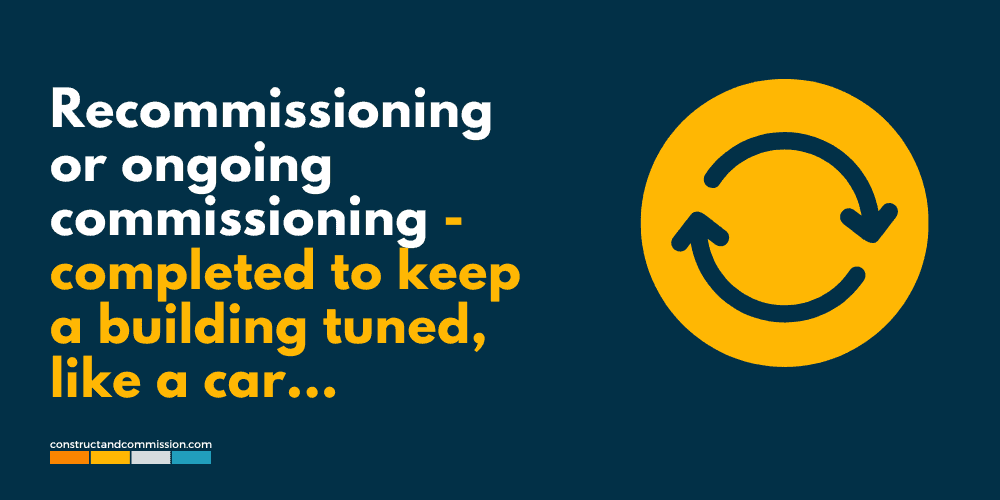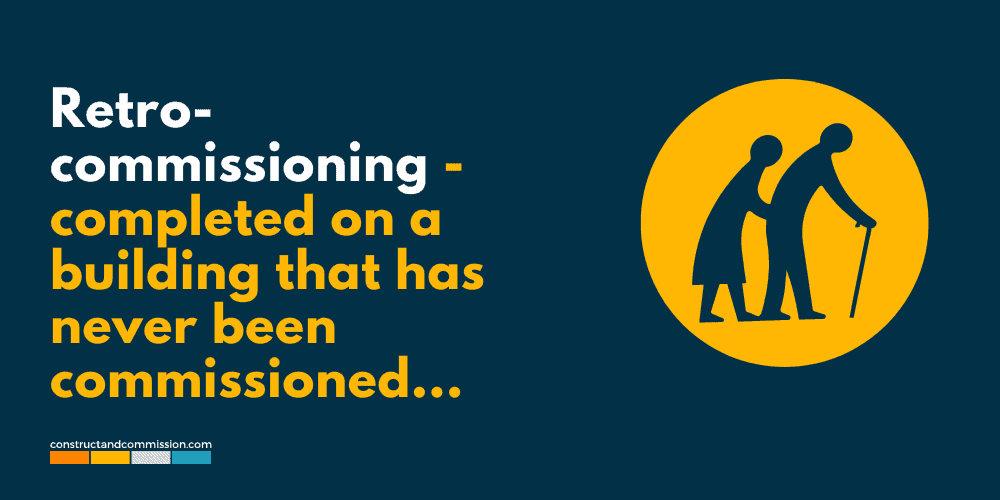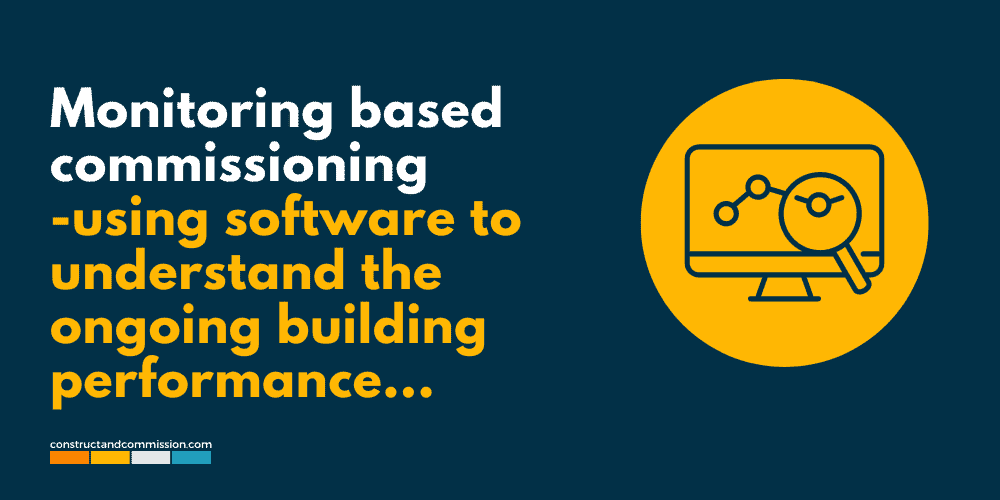Within the construction industry, there are commonly FOUR different types of commissioning that are widely deployed and delivered, depending upon the type of project/building:
- New Construction Commissioning [NCCx]
- Re-Commissioning/Ongoing Commissioning [OCx]
- Retro-Commissioning [RCx]
- Monitoring Base Commissioning [MBCx]
Below we explain more.
New Construction Commissioning [NCCx]

‘New Construction Commissioning’ or just ‘Commissioning’ is the most common type of commissioning we come across; the process and tasks should be completed when a project is being constructed as ‘new,’ for example, started from a green/brownfield site, or fit-out of a new space.
Positives in using New Construction Commissioning
Deploying a commissioning process and completing the relevant tasks and activities during the initial design, design, construction, and handover of a new building will be:
- Help to monitor and note any issues and observations relating to the installation quality,
- Overall, user experiences will be better due to ensuring comfort levels are met,
- Managing and fine-tuning the systems and equipment to help ensure that the building only uses the energy needed,
- Managing the energy usage helps ensure that the utility bills are kept to a minimum, only paying for what the building needs to operate, aiding cost savings over if the building was not commissioned,
- Documenting the commissioning process and testing activities to allow all future works and commissioning a baseline,
- Aiding future facility maintenance of systems and equipment,
- Help manage the overall handover process.
Who would complete the work?
It would be completed by a project team including the Client | Building Operations | Commissioning Consultant | MEP Designer | Main/General Contractor | Sub-Contractors | Vendors | Testing/Adjusting and Balancing Contractor.
To read more on the commissioning process that can be deployed for the majority of commissioning types, see our article: 'THE COMMISSIONING PROCESS | Explained with Flow Diagram'
Recommissioning/Ongoing Commissioning [OCx]

Buildings need a service and tune from time to time, similar to a car, ensuring it is running optimally and; as long as the usage of the spaces has not been modified, in line with the original Owners Project Requirement document [OPR] and Basis of Design [BOD], maintaining the initial expectations.
This type of Commissioning would usually be planned as part of the overall maintenance programme or at a time any existing equipment/system has been modified.
Positives in using Ongoing Commissioning
Conducting this process throughout the buildings lifetime would aid in the following:
- Ensure that the systems of the building are being maintained,
- Managing the energy costs over time, helping them to be held at the level expected within the original design,
- Help observe and spot any issues that need to be resolved with the systems, and then manage any remedial works,
- Maintain the overall comfort levels with the spaces of the building helping the users,
- Manage costs regarding works and maintenance by understanding issues earlier
- Aid the maintenance process to be focused more on planned maintenance than reactive maintenance,
- Allow the maintenance teams to increase their overall knowledge of the systems and equipment, especially if they start working within the building years after the handover.
Who would complete the work?
Recommissioning would be completed by a team including the Building Operations | Commissioning Consultant | Vendors | Testing/Adjusting, and Balancing Contractor.
Retro-Commissioning [RCx]

Retro-Commissioning works and activities are conducted where a building has been completed, handed over, and is in operation but has not had its equipment, systems, and services commissioned.
It is rare to find a new building that has not been commissioned to some extent, like the major plant and equipment, but sometimes we do. This can be due to some clients not fully understanding the expected final operation or use of the building, maybe they have a tenant who may want to use the space for a data center or another who wants it for storage.
Once the usage is known and agreed upon, the property owner would then instruct the Commissioning of the systems after any remedial / enhancement works have been completed to meet the new tenants’ use and requirements.
Positives in using Retro-Commissioning
Where the final usage of a building is not known, not fully commissioning it would aid the following:
- Ensure that the Commissioning is only deployed for the usage of the complete building,
- Helps manage the costs efficiently relating to the commissioning activities and management,
- Reduces works that will need to be repeated once building usage is known.
Who would complete the work?
Retro-commissioning would be completed by a project team including the Client | Building Operations | Commissioning Consultant | MEP Designer | Main/General Contractor | Sub-Contractors | Vendors | Testing/Adjusting and Balancing Contractor.
Monitoring Based Commissioning [MBCx]

Monitoring Based Commissioning follows the general construction commissioning process. It is used when a client or operator wants to understand, plan and optimize their building’s systems and equipment to maintain efficiency throughout its lifetime.
Useable data is gathered [BMS/BAS, Weather & Energy) by collecting it from the system’s sensors and instruments; this information would then be sent to a 3rd party software located in the ‘cloud’ where it is processed and analyzed via predetermined algorithms and ‘rules’ to understand if the building’s systems are operating in line with the design intent and how were initially set up, or if there are any issues that need to be investigated further, tuned or enhanced, that could affect the maintenance, plant replacement, and energy usage.
The building operator team will review these reports and discuss to make decisions on any potential remedial actions that may be required or have been suggested by the system.
This type of system should be considered during the early stages of a project to ensure it is planned and designed to the expected operational requirements.
Significant savings can be experienced by deploying this type of commissioning.
Positives in using Monitoring-Based Commissioning
There are some really good benefits to using this type of system, mainly during the overall building operating phase:
- If setup early enough within the project, it can be used effectively to aid the commissioning activities and process,
- Helps manage and monitor the energy usage of the building,
- Management of utility bills,
- It provides a great way of clearly visualizing the building data,
- Can aid in predicting failures of plant and equipment [if using the fault detection & diagnostics element],
- Helps to monitor run times of plant and equipment quickly, highlighting any that are not in line with the original timers,
- Provides additional information, if needed, to investigate any unexpected plant and equipment failures
- Can have a reasonable return on investment [ROI]
- Aid in fine-tuning the building, extracting savings,
Who would complete the work?
Monitoring-based Commissioning would be completed by a project team including the Client | Building Operations | Commissioning Consultant | MBCx Designer/Supplier | MEP Designer | and Main/General Contractor.
⬛ Related Articles
TRAINING MANUAL | for Operational Staff at Handover with Template
FACTORY ACCEPTANCE TESTING | Guideline, Agenda & Report
RFI vs RFQ vs RFP | Understanding the Differences
[RFI] REQUEST FOR INFORMATION | What is it in Construction with Templates
DATA CENTER | Commissioning Guideline & Template
COMMISSIONING CHECKLISTS | The 3 Types Explained and Templates Listed

